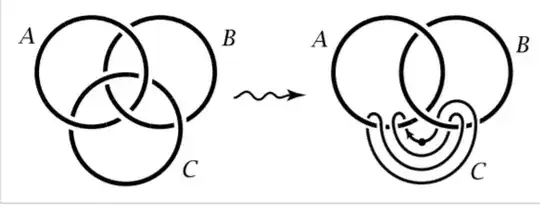I am reading the book Algebraic Topology by hatcher and more precisely the section about the fundamental group and have some questions about the intuition of the fundamental group. He starts this chapter with some intuitive examples on page 31 in the PDF (22 in the book). The setting he starts with is to imagine two circles in $\mathbb{R}^3$. He proceeds to consider one circle $A$ and a loop $B$ linking a multiple times. Two loops can then be added/multiplied in the usual way and he asks whether it is possible to continuously deform the sum of loops $B_1,B'_1$ to a loop that does not link $A$ at all.
Q1: In a more rigorous setting, am I understanding it correctly that he considers $\mathbb{R}^3 \setminus S^1$ or rather $\pi_1(\mathbb{R}^3 \setminus S^1, x_0)$ and inspects first, whether this fundamental group is trivial (which it is not, since on can just link the hole with another circle) and proceeds by inspecting whether the sum of loops can ever be $0$, meaning homotopic to a constant path? In the following picture that is taken from the book, one can see that $B_1 + B_{-1}$ can be deformed to $B_0$ which should be deformable to the constant path in $x_0$, right? (One pulls the piece of the loop that is in front of the circle behind the circle and then contracts it to $x_0$). 
So what he is essentially saying is that, although two loops might be non trivial in $\pi_1$, it might be that their sum is trivial.
He proceeds to regard an example called the Borromean rings, where he "fixes $A,B$" and considers $C$ as a loop, meaning, if I understand it correctly, that the space is now $\mathbb{R}^3$ minus two circles. Again he asks, whether it is possible to deform $C$ to unlink it from $A,B$ or in other words to inspect whether the fundamental group of the space is trivial (more precisely he can conclude that it is not, when $C$ can't be deformed in this way).
He says that the loop $C$ goes forward through $A$, then forward through $B$, then backward through $A$ and backward through $B$, meaning we would have $1+1-1-1=0$ if we would give this process a representation in $\mathbb{Z}$. He justifies this phenomenon by saying that $C$ is not linked with $A$ and $B$ individually.
Q2:As far as I understand, he means here, that when "removing" $A$ or $B$ and only regarding the circle that is left and $C$, one would have a trivial loop, right? I am a bit irritated here. Is this related to the fact that $\pi_1$ needn't be abelian? As far as I can tell, this loop should not be trivial, however, if this represents the sum in $\mathbb{Z}$ it would be trivial. I suspect that this has something to do with another fundamental group other than $\mathbb{Z}$ underlying here, which might explain this.
Lastly, he now assumes that $A$ and $B$ are now linked and says that it is apparent that $C$ can be unlinked from $A$ and $B$ as in the following picture. 
Q3: I may be overseeing something obvious, but I don't see how $C$ can be unlinked in any of the two pictures. If someone could explain it, I would be very grateful.
If I am missing something that he wanted to say in this section, I would also be greatful to learn about that. Thank you in advance!